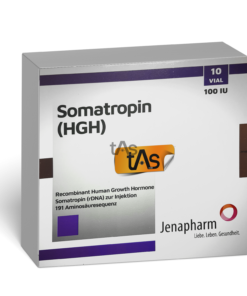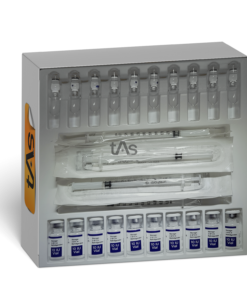No products in the cart.
TESAMORELIN (5MG)
$250.00
- GBP: £ 197.60
GROWTH HORMONE
WEIGHT LOSS
LEAN BODY MASS
STRENGTH
Tesamorelin is the cadillac of growth hormone secretagogues by stimulating the pituitary to secrete somatropes which is growth hormone. it has also been shown to burn fat or lipids to aid in weight loss
5mg
Category: HGH
DOSAGE
Inject 15 units subcutaneously daily.
Tesamorelin is sold in powder form and must be mixed with water (reconstituted) before use. Like other peptides, Tesamorelin is highly fragile and must be gently mixed with sterilized water. Once reconstituted, it should be stored in the refrigerator and used within the recommended period.
This drug is administered subcutaneously through injection. Your physician should advise you on a safe dose depending on your needs. If you use it as a bodybuilding and fat loss aid, you may get better results by combining it with a good diet and strength workout regime.
CONSIDERATIONS
What Tesamorelin side effects should i look out for?
Although peptides are considered generally safe, you should be aware that Tesamorelin can cause some side effects. If you are taking other medication, you should consult a doctor before taking this peptide as it is known to interact with certain medications. Similarly, pregnant women and those with diabetes should not take Tesamorelin. Some of the side effects to look out for are:
- Muscle pain
- Swelling or redness at the injection site
- Headaches
- Nausea
- Itching
- Vomiting
- Night sweats
GENERAL CONSIDERATIONS
Medical Consultation:
Always consult with a healthcare provider or medical professional before starting any peptide-based treatment. They can assess your specific health needs, potential interactions, and contraindications.
Allergies and Sensitivities:
Some individuals may be allergic or sensitive to specific peptides or ingredients in peptide formulations. If you have known allergies or sensitivities, inform your healthcare provider before starting any treatment.
Drug Interactions:
Peptides may interact with certain medications. It’s important to discuss all medications, supplements, and treatments you are currently taking with your healthcare provider to identify potential interactions.
Dosage and Administration:
Follow the recommended dosage and administration instructions provided by your healthcare provider or the manufacturer. Avoid self-dosing or altering dosages without professional guidance.
Contraindications: Some peptides may have contraindications for certain medical conditions. Your healthcare provider can help determine if a specific peptide is safe for your condition.
Pregnancy and Breastfeeding:
If you are pregnant, planning to become pregnant, or breastfeeding, consult with a healthcare provider before using any peptides. Safety during pregnancy and breastfeeding may vary.
Potential Side Effects:
Be aware of potential side effects associated with specific peptides. While many peptides are considered safe, side effects can occur, and it’s important to discuss any unusual symptoms with your healthcare provider.
Quality and Source:
Ensure that the peptides you use are obtained from reputable sources and are of high quality. Quality control is crucial to minimize risks.
Monitoring:
Depending on the peptide and its intended use, your healthcare provider may recommend regular monitoring of certain health parameters, such as hormone levels or blood markers.
Long-Term Effects:
The long-term effects of some peptides may not be well understood, so it’s important to discuss your treatment goals and duration with your healthcare provider.
Compliance:
Adhere to the recommended treatment plan and schedule provided by your healthcare provider. Skipping doses or discontinuing treatment prematurely may affect the desired outcomes.
Individual Response:
Peptides can have variable effects from person to person. Be patient and realistic about the expected results, and communicate regularly with your healthcare provider about your progress.
Remember that peptides are a relatively new area of research and clinical use, and the understanding of their safety and efficacy is continually evolving. Consulting with a knowledgeable healthcare provider who is experienced with peptide therapies is essential for making informed decisions about their use.
ALL ARTICLES AND PRODUCT INFORMATION PROVIDED ON THIS WEBSITE ARE FOR INFORMATIONAL AND EDUCATIONAL PURPOSES ONLY.
The products offered on this website are not medicines or drugs and have not been approved by the FDA to prevent, treat or cure any medical condition, ailment, or disease.
BENEFITS
Tesamorelin stimulates growth hormone release, aids in fat loss, and supports muscle maintenance.
RESEARCH
Tesamorelin is a peptide used to stimulate the release of growth hormone. It has been studied in the context of HIV-associated lipodystrophy, where it may help reduce excess abdominal fat. Tesamorelin was approved by the FDA in November 2010 as a drug to reduce fat accumulation in people with HIV. This is because HIV medication was seen to increase fat in certain body parts, particularly the belly and back areas.
FAQS
What is Tesamorelin, and what is it for?
Tesamorelin is a synthetic peptide hormone that acts as a growth hormone-releasing factor (GHRF). This means that it stimulates the pituitary gland to release the growth hormone into the bloodstream. On the other hand, the human growth hormone is a hormone produced by the pituitary gland located at the base of the brain. Its primary role is to spur muscle growth, boost metabolism, support cell repair, and promote fat loss, among other benefits. Low levels of the growth hormone, for instance, are linked to higher amounts of belly fat. Tesamorelin is one of the most significant growth hormones stimulating peptides available.
What is the origin of Tesamorelin?
Tesamorelin was approved by the FDA in November 2010 as a drug to reduce fat accumulation in people with HIV. This is because HIV medication was seen to increase fat in certain body parts, particularly the belly and back areas. Although used to decrease fat in the body, Tesamorelin is not a fat loss drug, but rather, it is a human growth hormone-releasing factor analog. Its ability to target fat loss in particular areas such as the belly makes it attractive to bodybuilders and other fitness enthusiasts.
How does Tesamorelin work?
As mentioned, Tesamorelin is a synthetic version of the human growth releasing hormone, which is naturally produced in the hypothalamus. Once the Tesamorelin peptide is injected into the body, it stimulates the pituitary gland to release the growth hormone into the bloodstream. The growth hormone then goes to work to boost metabolism, leading to better fat utilization and, therefore, reducing abdominal fat. It also increases protein production and increases energy levels. This can lead to bigger muscle growth and enhanced endurance.
What happens when human growth hormone levels are low?
The growth hormone (GH) is required for various vital processes in the body. It supports metabolism; the process by which the food we eat is turned into energy in the body. GH also increases muscle mass, strength, and reduces body fat. As we age, our growth hormone levels start to decline, sometimes as early as the age of 30. This can result in fatigue, slower recovery times, fat increase particularly in the belly and muscle mass loss. Similarly, low GH levels can lead to depression and loss of libido. Increased production of this crucial hormone can reverse most of these effects.
Be the first to review “TESAMORELIN (5MG)” Cancel reply
Related products
$400.00
- GBP: £ 316.15
Sale!
Ancillaries (USA)
- GBP: £ 147.11








Reviews
There are no reviews yet.